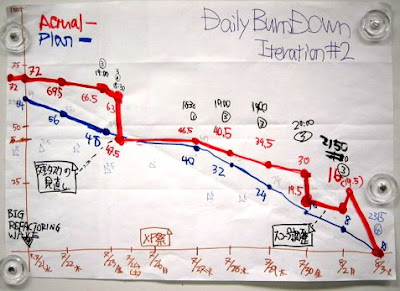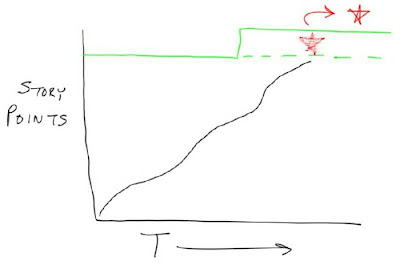
A (the?) primary essence of agile is to focus on delivering value-adding functionality as often as possible. Value-adding, that is, from the point of view of your consumer.
[Quick aside: we most often think of this in terms of value-adding 'application software', but certainly not by rule - it is whatever it is that is of value to your consumer. If you don't have a consumer, or if you aren't bringing value, then why are you spending time on it? Anyway...]
The implication of this is that many tasks we perform, while in most instances are in fact (hopefully) necessary, do not in and of themselves provide any real 'customer' value. In software terms, for example, this means that while "analysis" or "coding" or "testing" activities might in fact be necessary, they are not what our consumer/customer seeks…it is "a working feature" only that truly provides the value.
Let's bring into the discussion that holy agile grail we call a "story" (a symbol/moniker for a value-adding feature) - it is assumed that all the tasks that have to occur to deliver a story will occur, but alas, we simply should not be giving or getting any cookies for completing these tasks. We get cookies only for delivering [running, tested] features; we get cookies for delivering value.
More to the point of where I'm going with this, its not really to any benefit then to explicitly track these tasks (ie, track, meaning in your reports, "backlog" if that's a tool of yours, or things similar). Why? Well, primarily, simply because it is the story (feature) we strive to deliver, not necessarily analysis or code, etc.
(Taking a bit of a tangent here, but its an important one...) "Deliver value as often as possible". The further implication here is that we also strive to break the feature up into smaller and smaller pieces (stories); the smaller, the quicker it can be delivered, eh? And, further, the smaller the more likely to have an accurate estimate; the easier to design in an evolutionary way; the easier to test; etc. But in the end, with respect to our "stories", no matter how small we split, we do not split by tasks - each split in and of itself must still provide some sort of demonstrable value. Anyhoo...
"So Mike," you say, "where in the world are you going with all this?!?!". Great question, here it is: (MBark of this post) Do away with your "burndown charts".

The sprint "burndown" [pictured left], at least as prescribed by Scrum, is tracking tasks. Being we like not to focus on tasks, and being we only get cookies for completed stories, doesn't a burndown focus us on the wrong thing? Yes, it does. Bad burndown, bad. In addition to focusing us on the wrong things, it burdens us to worry about too many things; to, in many ways, encourage us to micro-manage (which, of course, is not good for anybody and very un-agile). If you need more, how about the fact that it can lead quite readily to false-negatives with respect to how "done" you really are: "great, Bob, you've got task x, y, and z's hours all used up, sweet!"...but, uh, what the heck does that really mean with respect to the status of obtaining your real goal (delivering the feature)?

Thus, a "burnup" [pictured right]. A burnup tracks only features (whatever that might mean in your context); the features represented by stories, each assigned a point value to indicate size. When a story is complete (a feature is "done"), the burn goes "up" by that feature's points. No hours, no tasks, no minutiae about various random "inputs" - rather, just a simple representation of what we really care about - features being output. Easy-peasy, and way more in line with our goals. And, of course, as far as contributing as a tool to help us determine our velocity: if we really need to measure anything, what we really want to be measuring is our rate of delivering working software, not our rate of "doing analysis", right?
Be not mistaken by my message, it's not to say you and your team won't have daily knowledge of what particular tasks might be going on, I sure as hooha hope you do! It's just that we don't go so far as to officially track or measure them. That's what your daily stand-up is for. And, of course, common sense is required, if you really want them to be visible, fantastic (I mean it) - go ahead and hang up some task stickies on your Storyboard or some other "information radiator" hanging in your team room.
But, alas, my spidey-sense says: unless you're hoping to burn down your project, steer clear of the Burndown chart.





This is amazing: I was arguing the exact same thing yesterday too. Thanks for the post.
ReplyDeleteI never really knew much about Scrum, but I did play rugby in high school, and I can tell you that a scrum can be a pretty rough place to be.
ReplyDeleteBut Scrum with a capital S? I dunno. They have some strange metaphors that make me go "eech". And yes, you're right: stories are more important that tasks.
The more I hear about Scrum, the more puzzled I become.
I agree that at a sprint-level we need to focus on evolution of features complete, not tasks performed -- and some teams have been doing that -- however that doesn't alleviate the need for measuring the execution of tasks within a story. If a story is late because tasks were not performed as planned, it is still late. This may mean just measuring at a lower granularity level, but doesn't still need to be done, even if done by each team-member for the tasks they are responsible for?
ReplyDeleteHi Tony --
ReplyDeleteI'm not sure I exactly understand your question, but let me give this a shot in case I do.
I'm not saying that it's bad to be aware of the necessary tasks involved in completing a story, or even that its bad to know their status at any given time. You should.
But what I'm suggesting is that you handle this less formally than by tracking "hours remaining" in a burndown chart or anything similar. Is it not sufficient to use verbal communication within a team, possibly supplemented by sticky notes on the wall to stay on top of this?
Does this help to answer your question?
Cheers
MB
This is interesting but I think there is a small fallacy in that all Agile brings to the table is delivering value in the form of features. Sure, to the user of the software that is all that matters, but to the stakeholders sometimes they see value in knowing when will you be done.
ReplyDeleteDon't get me wrong, everything you say about burndown charts is indeed muda, but it's secondary muda not primary muda, so sometimes you just live with it.
Burndown charts are a tool. Just like any tool you can use them wisely or poorly. The key is to recognize when you are using your tools poorly and learn to use them wisely or switch to tools more relevant to your tasks.
@Tony
ReplyDeleteWe never track at the task level. We barely track at the story level. Out burndown chart works like this (we don't actually have a chart):
Customer: When will we be done?
Developer: Well, you have 32 points in this release, and we are doing 8 points an iteration so about 4 iterations.
Customer: We need a release in two
Developer: Well then we need to look at what is the minimum set of stories that provide the most value we can do in 16 points.
Curtis --
ReplyDeleteThanks for your thoughts.
I think we have nothing more than a semantical confusion.
I absolutely agree having a projection and (even more so) a radiator to track and update progress toward that projection is good. Other words, we're in agreement.
All I'm saying is that using a "burn-down" as it is traditionally prescribed - tracking development tasks - is yicky.
The conversation you describe above, that's a "burn-UP"-ey discussion, which I'm all for.
Cheers
MB